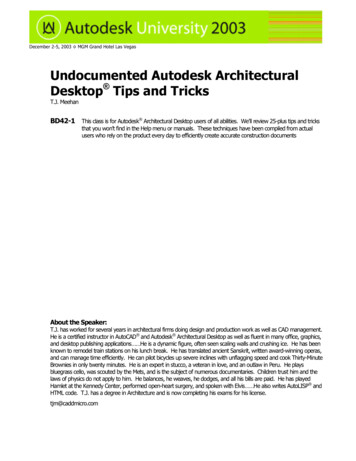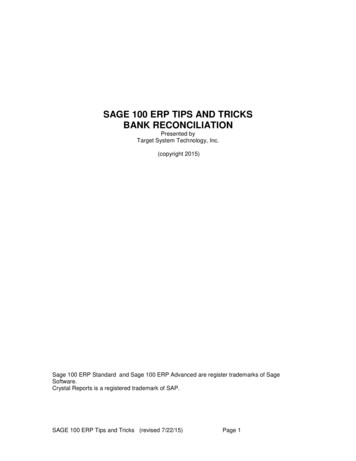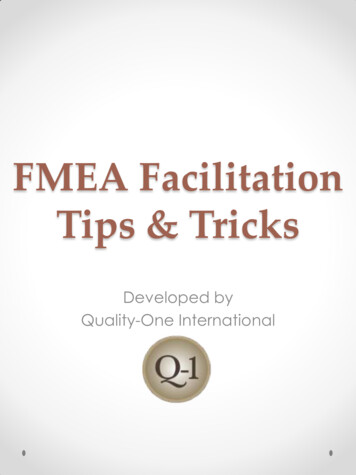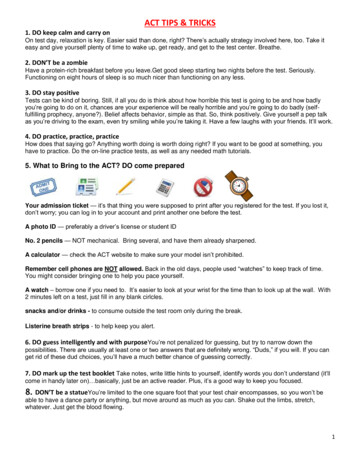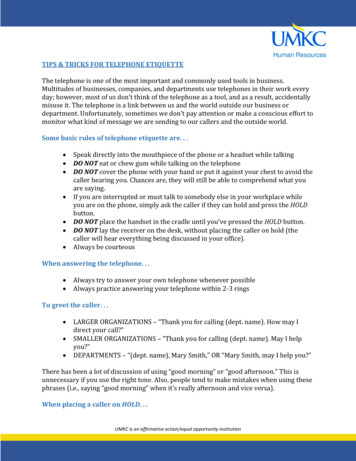
Transcription
Human ResourcesTIPS & TRICKS FOR TELEPHONE ETIQUETTEThe telephone is one of the most important and commonly used tools in business.Multitudes of businesses, companies, and departments use telephones in their work everyday; however, most of us don’t think of the telephone as a tool, and as a result, accidentallymisuse it. The telephone is a link between us and the world outside our business ordepartment. Unfortunately, sometimes we don’t pay attention or make a conscious effort tomonitor what kind of message we are sending to our callers and the outside world.Some basic rules of telephone etiquette are. . . Speak directly into the mouthpiece of the phone or a headset while talkingDO NOT eat or chew gum while talking on the telephoneDO NOT cover the phone with your hand or put it against your chest to avoid thecaller hearing you. Chances are, they will still be able to comprehend what youare saying.If you are interrupted or must talk to somebody else in your workplace whileyou are on the phone, simply ask the caller if they can hold and press the HOLDbutton.DO NOT place the handset in the cradle until you’ve pressed the HOLD button.DO NOT lay the receiver on the desk, without placing the caller on hold (thecaller will hear everything being discussed in your office).Always be courteousWhen answering the telephone. . . Always try to answer your own telephone whenever possibleAlways practice answering your telephone within 2-3 ringsTo greet the caller. . . LARGER ORGANIZATIONS – “Thank you for calling (dept. name). How may Idirect your call?”SMALLER ORGANIZATIONS – “Thank you for calling (dept. name). May I helpyou?”DEPARTMENTS – “(dept. name), Mary Smith,” OR “Mary Smith, may I help you?”There has been a lot of discussion of using “good morning” or “good afternoon.” This isunnecessary if you use the right tone. Also, people tend to make mistakes when using thesephrases (i.e., saying “good morning” when it’s really afternoon and vice versa).When placing a caller on HOLD. . .UMKC is an affirmative action/equal opportunity institution
Remember to ask your caller “Do you mind holding?” or “May I put you on hold?”before doing so.If you take the time to ask your caller to hold, be sure to listen to the response.After placing your caller on hold, check back periodically (between 30-45seconds). Give them the option to continue to hold if it will take longer to findinformation OR offer to call them back.When returning to your caller, remember to thank them for waiting.If your caller cannot hold, offer to take a message; transfer to another party; orarrange for them to return the call at a specific time.If you are not in a position to ask your caller to hold, tell the caller, “Please Hold”before depressing the hold button. NOTE: When placing multiple calls on hold,remember to return to the first caller you placed on hold first!!When you are transferring a phone call. . .1) Make sure to explain to the caller the REASON why you are transferring their call2) Verify that it is all with the caller for you to transfer them3) Call the department or person where you are transferring a call to and make surethat they can take the call. If they are able to take the call. . .o Give them the person’s name, request, and any other relevantinformation.4) Return to your caller and give them the name of the person they are beingtransferred to, the department and the telephone number (if possible).*When you’re not sure to whom a call should be transferred to, take the caller’s name andtelephone number and find out where the call needs to be transferred to. Also, give the calleryour name and phone number as a reference in case the appropriate party does not contactthem.SCREENING TELEPHONE CALLSThere is a lot of controversy over whether or not telephone calls should be screened. It isnot recommended to screen calls if you want to enhance or encourage good publicrelations. You should always lean towards not screening calls if at all possible. “Yes he’s in.May I tell him who’s calling, please?” is an example of an appropriate response when youare not screening calls.If someone is available ONLY to certain individuals and you must screen phone calls, leantowards using responses like, “She’s away from her office; may I take your name andnumber?” OR, “May I ask who’s calling? Thank you. Let me check and see if he’s in.”2
*If you are required to ask who is calling or what the nature of the call is, be aware of yourtone of voice. Screening calls is always a delicate situation, so it is critical not to offend or putyour caller on the defensive with your voice tone.THE“IN CONFERENCE” TRAPPhrases such as the two phrase, “He’s in conference” or “She’s in a meeting,” are greatlyoverused, so many people don’t believe you when you use this phrase. The mostappropriate response you can give a caller is that someone is not available or unavailable;however, it is crucial afterwards to indicate when the person will be availableEx. “She’s not available, but I do expect her back in the office at 3:00 p.m.”DO NOT use responses such as: He isn’t in yetShe’s out for coffeeHe’s gone for the day (and its 3:00 p.m.)She’s in, but she’s busy***NOTE: If, on occasion, you say that an individual is “in a meeting,” ALWAYS includean approximate time when he or she will be available or out of that meeting.When taking messages. . .Always try to use telephone message forms, if available, to record messages. Telephonemessage forms practically guarantee for accurate, organized phone messages along withobtaining complete information.A good phone message includes: Name of person for whom the message was leftCaller’s name (get the correct spelling), company or dept. and numberDate and timeMessageAction to be taken (i.e., “Please Call,” “Will call back,” or “URGENT”)It is crucial to deliver the message to the person it is intended for as soon as possible and tomaintain confidentiality with all messages. When delivering a written message, either turnthe message over or fold it in half, as to not risk them being easily read by other staffmembers or visitors.When returning a phone call. . .3
Playing phone tag can be frustrating, so to avoid returning phone calls to a person who isunavailable, try establishing specific times to call-back or try asking, “When is the best timefor me to call again?” or “When is the best time for them to call me back?”*When taking calls for another individual, schedule return calls during specific blocks oftime.Ex. “I expect him to return by 2:00 p.m. You can reach him between 2 and 5”).When placing Outbound Calls. . .Be sure you have the right telephone number before you place an outbound call. Keeping a“frequently called numbers” list within reach could prove be very helpful. Try utilizing afew of these suggestions: Prepare yourself. Visualize your caller as a friendly, positive personPlan the objectives you want to accomplish by jotting them down ahead of timeState your concerns up front to identify the information you need to obtain fromthe conversationAssume what questions or objections you may encounter prior to placing the calland devise answers to them to avoid making additional callsTake notes during the outbound callSpecify any follow-up action to the caller, such as, when you plan to get back tohimWhen you are leaving a message. . .When you reach an answering device, such as a voice mail or an answering machine, besure to leave the following information: Your name and the correct of you name spelling (if necessary).Your department and telephone numberThe date and time you calledMessageWhen you are available to take callsTo conclude the conversation. . .Many people dread bringing a telephone conversation to an end. Here are some tips toavoid any awkwardness and to close your conversation with professionalism: Talk in the past tense.Try utilizing a “closing” phrase, such as, “I’m really glad you called” or “I’m gladwe resolved this concern.”State the action you will take.4
Assert any follow-up actions, such as time frames or deadlines.Thank them for calling and say “Good-bye”. Refrain from using slurs, slang, orphrases, such as, “bye-bye,” “Okie-dokie,” or, “Alrighty.”PROPER TELEPHONE LANGUAGEAlthough we express a lot to our callers through the sound and the tone of our voice, whatwords and phrases we use in a conversation can also convey a significant message.Sometimes people neglect this and end up delivering a negative message to the caller. Payattention of what type of language you are using. For example, instead of beginning asentence with phrases like, “You have to-,” You need to-“, or, “Why didn’t you?” try startingwith words like, “Will you please?’ or, “Would you please?”Never refer to a matter or inquiry as, “Your problem” or “Your complaint.” Instead, tryusing better phrasing and identifying it as something along the lines of, “Your question,”“Your concern,” or, “This situation.” When you do not have the knowledge or expertise tohandle a caller’s situation, never reply with remarks like, “I can’t do that” or, “that’s not myjob.” Instead, try a more helpful approach by outlining what actions and steps you arecapable of taking to aid their situation.Ex. “While I’m not able to establish policy on this matter, I will speak to my managerabout your concern.”Avoid coming off as abrupt and unprofessional by all means, and refrain from usingexpressions, such as: “Hang on.”“Hold on.”“Who’s calling?”“I can’t hear you, speak up!”“I can’t help you. You’ll have to speak to someone else.”The following terminology would be more appropriate: "May I put you on hold?”“May I say who is calling please?”“I am having a little difficulty hearing you. Can you please speak up?”“I need to transfer your call to (dept.) so that they can answer your question. May Ido so?”5
3) Call the department or person where you are transferring a call to and make sure that they can take the call. If they are able to take the call. . . o ive them the person’s name, request, and any other relevant inf
![[IV‐ADV‐9‐A] Tips and Tricks for Payroll and Human Resources](/img/9/tips-and-tricks-payroll-and-hr.jpg)





